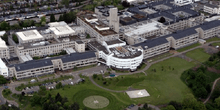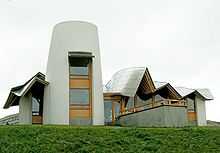Ninewells Hospital
| Ninewells Hospital | |
|---|---|
| NHS Tayside | |
 Ninewells Hospital | |
| Geography | |
| Location | Dundee, Tayside, Scotland |
| Organisation | |
| Care system | NHS Scotland |
| Hospital type | Teaching |
| Affiliated university |
University of Dundee Abertay University |
| Services | |
| Emergency department | Yes |
| Beds | Acute: 995,[1] ICU: 20, MAU: 30, TCH: 70 |
| History | |
| Founded | 1974[2] |
| Links | |
| Website | http://www.nhstayside.scot.nhs.uk/patients/hospital/ninewells.shtml |
| Lists | Hospitals in Scotland |
Ninewells Hospital is the largest teaching hospital in Europe, based on the western edge of Dundee, Scotland. It is internationally renowned for introducing laparoscopic surgery to the UK as well as being a leading centre in developing fields such as the management of cancer, medical genetics and robotic surgery. Within the UK, it is also a major NHS facility for psychosurgery.[3] The medical school was ranked 1st in the UK in 2009.[4] The hospital is administered under NHS Tayside and also has nursing and research links with the University of Dundee.
History
The proposal for the new hospital was put forward in May 1960 and final permission was accepted by Parliament in February 1962. The first phase of the project was due to take 6 years at a cost of £9 million. Designed by Robert Matthew Johnson-Marshall and partners, the protracted construction began in August 1964. The hospital was initially designed to hold 800 beds, and the ward units were planned on the 'race track' principal. The foundation stone was laid on 9 September 1965, by Baron Hughes of Hawkhill.[2] The infirmary was built onto the side of a hill and the practicalities of the design were influenced by airport check in. Phase I of the building was completed in 1973, although some sections were not finished until 1975. The final cost was estimated as £25 million. Hospital admittances started in January 1974 and the hospital was officially opened by the Queen Elizabeth The Queen Mother on 23 October 1974. At the opening ceremony, she stated "nothing that science can devise, nor money provide, will be lacking for the treatment of the patients".[5]
The opening of Ninewells had a major impact upon Dundee's existing hospitals. Dundee Royal Infirmary, opened in 1798, had been Dundee's main hospital until the opening of Ninewells. From 1974 many of its functions and responsibilities were transferred to Ninewells and the infirmary ultimately closed in 1998.[6][7] Maryfield Hospital, which had formerly been the East Poorhouse, was closed to patients in stages between 1974 and 1976 as a result on Ninewells opening.[8] In the 1990s and 2000s many functions of the city's King's Cross Hospital were also transferred to Ninewells.[9]

The hospital site also contains the first building in Britain designed by architect Frank Gehry, in conjunction with James F Stephen. The design was commissioned by Maggie's centres, the cancer support organisation, for their third centre at the hospital and was officially opened on 25 September 2003 by Bob Geldof.[10]
Ten million pounds has been spent redesigning and overhauling the paediatric department of the hospital and, in June 2006, it was officially opened under the name Tayside Children's Hospital.
The archives of the hospital are held by Archive Services, University of Dundee.[2] The same archive also has a collection of microfilm copies of plans and documents relating to the construction of the hospital by Robert Matthew Johnson-Marshall & Partners.[11]
Coordinates: 56°27′50.03″N 3°2′16.35″W / 56.4638972°N 3.0378750°W
The modern hospital
The hospital currently has just under 1000 acute beds and a 31-bed medical assessment unit. The hospital has two MRI scanners and a CT scanner available, which can be operated 24 hours a day, including weekends. The hospital provides services in accident and emergency, critical care, lung and colorectal cancer, palliative care and most medical and surgical specialties. The hospital has a team of anaesthetists on site 24 hours a day, and there are always at least two registered children's nurses on duty 24 hours a day in each children's ward. At the Maternity Unit in Ninewells, all newborn babies now have their hearing tested, with a dedicated hearing screener who carries out the tests to discover any problems as soon as possible after the baby is born.
The Accident and Emergency Department deals with 150,000 admissions – including 3,500 broken bones, 250 heart attacks and 20,000 X-rays.The department is the Regional Major Trauma Centre for Tayside and Fife, operating 24 hours a day this centre will accept any trauma cases from miles around with patients arriving by walk-in,land ambulance or by air ambulance landing on the hospitals state of the art helipad. The Tayside Pre-hospital Trauma Team operate from the emergency department providing on-scene critical care for the most seriously injured patients in east of Scotland From 2016 The hospital will be one of 4 major trauma centres where specialist services are based as part of a new national major trauma network in Scotland.[12]
In addition to the hospital, there is a teaching section that includes the Ninewells medical school and the nursing school of University of Dundee. As such it was the second purpose built medical school in UK, and has garnered a reputation for excellence in academic research.[5] In particular the hospital has one of the world's leading leukaemia research units.[13]
Tayside Children's Hospital
Tayside Children's Hospital is a children's hospital located within Ninewells Hospital. It serves children, age from birth up until their fourteenth birthday, who live in Dundee, Angus, Perth and Kinross and north east Fife and, as such, it was so named after a region rather than a city to reflect the wide area that it covers.[14]
The facility, which cost ten million pounds to fund, was formally opened on 7 June 2006 in a ceremony involving television celebrity Fred MacAulay, University of Dundee principal Sir Alan Langlands, nurses, doctors and young patients.[15] The hospital combines medical services for children aged from prenatal to fourteen years of age with research departments specialising in paediatrics, and was financed by NHS and Dundee University funds and with money raised by various children's charity organisations. The major driver behind TICH was the professor of Child Health Richard Olver, who spent a considerable period of his latter years in post campaigning for funds from charities and the public sector.
Included within the hospital are Ward 29 (the children's medical ward), Ward 30 (the children's surgical ward), Ward 40 (the neonatal unit), a high dependency unit, the maternity department, children's surgical rooms, a children's outpatient clinic, an ambulatory bay and a Maternal and Child Health clinic. There are also an outdoor play area/garden and an indoor play centre, which also houses an area that provides entertainment equipment aimed specifically at adolescents, as well as Ronald McDonald suites for families to reside in while their child is hospitalised.[16] Clinical research into conditions such as cystic fibrosis, asthma, diabetes, prematurity, etc. is conducted at the unit in the hopes of developing further treatments and better enable medication trials that would normally only be offered to adults.
The idea of a children's hospital in Dundee had been considered since 1995 but, although the children's wards underwent major upgrading,[17]
Footnotes
- ↑ Healthcare Environment Inspectorate. Announced Inspection Report, Ninewells Hospital, NHS Tayside, 11 and 17 November 2009 (PDF) (Report). Retrieved 30 August 2010.
- ↑ 2.0 2.1 2.2 "University of Dundee Archives Services Online Catalogue Ninewells". University of Dundee. Retrieved 26 February 2014.
- ↑ Neurosurgery for Mental Disorders=http://apt.rcpsych.org/content/10/3/189
- ↑ "Ninewells Medical School tops UK rankings". The Guardian. 30 August 2009.
- ↑ 5.0 5.1 "Opening of Ninewells Hospital". Dundee Courier and Advertiser. 24 October 1974. p. 9.
- ↑ "Archive Services Online Catalogue THB 1 Dundee Royal Infirmary". University of Dundee. Retrieved 17 February 2012.
- ↑ McKean, Charles and Whatley Patricia, with Baxter, Kenneth (2008). Lost Dundee: Dundee's Lost Architectural Heritage. Edinburgh: Birlinn. p. 175. ISBN 978-1-84158-562-8.
- ↑ "Archive Services Online Catalogue THB 14 Maryfield Hospital". University of Dundee. Retrieved 17 February 2012.
- ↑ "Archive Services Online Catalogue THB 22 King's Cross Hospital". University of Dundee. Retrieved 17 February 2012.
- ↑ "UK's 1st building designed by Frank Gehry for pioneering cancer support". Maggie's centres. 26 September 2003.
- ↑ "MS 52 Robert Matthew Johnson-Marshall & Partners". Archive Services Online Catalogue. University of Dundee. Retrieved 16 March 2012.
- ↑ "Scotland trauma centres network 'to boost emergency care'". BBC News. 27 April 2014. Retrieved 13 July 2014.
- ↑ "Leukaemia research". Tayside. 13 September 2002.
- ↑ BBC (2006-06-06). "Dundee children's hospital opens". BBC News. Retrieved 2007-02-02.
- ↑ Medical News Today (2006-11-06). "Opening Of Tayside Children's Hospital". Retrieved 2007-02-02.
- ↑ Dundee University (2006-06-06). "Tayside Children's Hospital Opening day 7th June 2006". Retrieved 2007-02-02.
- ↑ Tayside NHS Board (2003-03-13). "Tayside Institute of Child Health Phase 2" (PDF). Retrieved 2007-02-02.